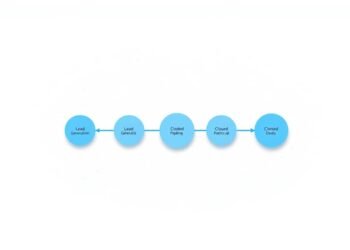What makes some brands instantly recognizable while others fade into obscurity? The answer often lies in a powerful positioning statement. This concise yet strategic message defines your brand’s unique place in the market, guiding both internal teams and customer interactions.
Unlike mission statements or value propositions, a positioning statement focuses on differentiation. It clarifies why your product stands out and resonates with your target audience. Companies like HubSpot leverage this tool effectively, reaching over 100,000 customers globally.
A well-crafted statement fuels business growth by aligning messaging across all channels. Ready to define your brand’s competitive edge? Let’s explore the steps to craft a compelling one.
Key Takeaways
- Positioning statements clarify your brand’s unique market space
- They differ from mission statements and value propositions
- Effective positioning drives customer recognition and loyalty
- Global brands use these statements to maintain messaging consistency
- A strong statement supports business growth and team alignment
What Is a Positioning Statement and Why Does It Matter?
Every memorable brand has a clear roadmap—its positioning statement. This internal tool defines how a product meets the needs of a specific target market. Unlike slogans or taglines, it’s a strategic compass for teams.
Definition of a Positioning Statement
According to marketing experts, a positioning statement describes a product’s unique role for its audience. It answers: “Why should consumers choose us?” For example, Nike’s sustainability focus isn’t just a mission—it’s woven into their differentiation.
Today’s buyers expect more. A 2023 report shows 63% prefer brands committed to social responsibility. This makes clarity in brand positioning non-negotiable.
The Role of a Positioning Statement in Brand Identity
During market shifts, companies like Payhip relied on their statement to stay consistent. Apple’s historical credibility? Rooted in a promise that resonated deeply.
A strong value proposition aligns teams and builds loyalty. It’s not just words—it’s the foundation of every decision.
Positioning Statement vs. Mission Statement vs. Value Proposition
Brands often confuse strategic messaging tools, but each serves a distinct purpose. A mission statement inspires, a value proposition convinces, and a positioning strategy defines your competitive edge.
How Positioning Differs from a Mission Statement
Nike’s mission focuses on sustainability and innovation. Their positioning, however, targets athletes with performance-driven products. Mission statements outline ideals, while positioning clarifies market space.
Coca-Cola’s mission evokes happiness globally. Their positioning zeroes in on being the top refreshment choice. One fuels purpose; the other drives sales.
Value Propositions Within Brand Positioning
A value proposition fits inside broader positioning. For example, Wistia’s template—”We help [businesses] grow with ”—supports their niche as a creator-friendly platform.
Marriott International blends both. Their brand promise (“Travel brilliantly”) aligns with tailored guest experiences. Parse.ly takes a data-driven approach, proving value through metrics.
Core Elements of a Strong Positioning Statement
Great brands don’t just happen—they’re built on clear, strategic foundations. A powerful positioning statement hinges on three pillars: knowing your audience, understanding the market, and showcasing what makes you unique.
Target Audience: Who Are You Serving?
Airhouse’s success with D2C brands proves precision matters. Identify your ideal target audience—demographics, pain points, and aspirations. For example, Ethos Water appeals to socially conscious buyers by tying purchases to clean-water initiatives.
Market Category and Competitive Landscape
Use perceptual mapping to spot gaps among competitors. Sapphire Ventures dominates by specializing in startup funding, a niche others overlook. Analyze trends to carve your space.
Unique Differentiators and Brand Promise
RateGenius’s 150-lender network isn’t just a claim—it’s a brand promise. Mailchimp’s award-winning support reflects its core values. What can your brand guarantee that others can’t?
How to Create a Positioning Statement: Step-by-Step Guide
Strategic differentiation begins with understanding your audience deeply. A structured approach ensures your brand stands out in a crowded market. Follow these five steps to build a foundation that resonates.
Step 1: Define Your Target Audience
Identify who needs your solution. Use tools like Alexa.com to build detailed buyer personas. For example, White Dog Distilling targeted craft spirit enthusiasts by highlighting local ingredients.
Step 2: Analyze Your Competitors
Study rivals using frameworks like Porter’s Five Forces. Look for gaps—Sapphire Ventures thrived by focusing on startup funding, a niche others ignored.
Step 3: Articulate Your Unique Value
What can only your brand deliver? RingCentral’s “any mode/device/location” phrasing captures flexibility. Test claims with data, like Mailchimp’s award-winning support.
Step 4: Craft a Concise Statement
Keep it clear and memorable. HubSpot’s “Help millions grow better” reflects their value in eight words. Avoid jargon—simplicity sticks.
Step 5: Validate with Stakeholders
Run workshops or surveys. Vision boards help teams visualize emotional connections. Refine until it aligns with your core values.
Tips for Writing an Effective Positioning Statement
The difference between forgettable and unforgettable brands often lies in execution. A strong message blends clarity, emotion, and strategy. Here’s how to refine yours.
Keep It Simple and Memorable
Slack’s “collaboration hub” phrasing proves simplicity wins. Avoid jargon—focus on one key benefit. Ask, “So what?” to trim unnecessary details.
Wistia’s broad product framing avoids feature overload. Short, punchy statements stick in consumers’ minds longer.
Align with Core Brand Values
Zendesk’s customer support philosophy mirrors its core values. Your statement should reflect what your brand stands for.
Parse.ly’s billion-user data storytelling turns numbers into relatable benefits. Authenticity builds trust.
Use Empathy to Connect with Your Audience
49% of buyers demand brand empathy (2021 CX Trends Report). Payhip’s creator-focused language shows understanding.
Map your audience’s pain points. Highlight how your solution improves their experience. Emotion drives action.
Common Mistakes to Avoid
Even strong brands stumble when their messaging misses the mark. Avoiding these pitfalls ensures your service stands out authentically.
Being Too Vague or Generic
Generic statements like “We deliver quality” fail to resonate. Compare “Help millions grow better” (HubSpot) versus “We help businesses.” Specificity builds trust.
Failed product launches often trace back to unclear differentiation. Transparency about your unique approach matters more than buzzwords.
Overpromising and Underdelivering
“10x growth guarantees” backfire when results fall short. Sapphire Ventures succeeds by setting realistic scaling expectations.
Align promises with actual service capabilities. Data from Parse.ly shows users value accuracy over hype.
Ignoring Competitor Positioning
CRM software brands often overlap because they skip competitive analysis. Track competitors to find whitespace opportunities.
Use insights from tools like Porter’s Five Forces. Understand what users truly need—not just what rivals offer.
How to Test and Refine Your Positioning Statement
Testing separates strong positioning from guesswork—here’s how to do it right. Even iconic brands like Coca-Cola refine their messaging based on data and people’s evolving preferences.
Gathering Feedback from Your Team
Cross-departmental workshops reveal blind spots. Sales teams often spot inconsistencies marketing misses. For example, a SaaS company found their strategy confused users—until HR flagged unclear phrasing.
Use feedback parameters like clarity and impact. A 2023 CX Trends Report shows 72% of brands adjust messaging after internal reviews. Map the customer journey to check alignment at every touchpoint.
Using A/B Testing for Messaging
Multivariate ad tests prove what resonates. An industry leader boosted conversions by 30% after testing two value propositions. Track metrics like engagement and competitor responses.
Long-term surveys measure brand awareness shifts. Global companies like Nike test campaigns in diverse world markets before scaling. Data beats assumptions every time.
Real-World Positioning Statement Examples
Leading brands dominate markets by turning strategy into action. Their success stories offer valuable lessons for businesses of all sizes. Let’s examine three compelling examples across different industries.
Tech Industry: HubSpot’s Growth Platform
HubSpot transformed marketing services with their full-stack approach. Their positioning focuses on helping millions grow better through integrated solutions.
Unlike generic CRM companies, they emphasize education and empowerment. This clarity helped them scale globally while maintaining consistency.
Consumer Goods: Coca-Cola’s Emotional Connection
Coca-Cola builds its brand around shared moments rather than just beverages. Their positioning creates an experience tied to happiness and nostalgia.
While competitors talk about hydration, Coke owns the emotional space. This distinction has kept them market leaders for decades.
Small Business: White Dog Distilling’s Artisan Story
This craft distillery makes local ingredients their selling point. Their positioning highlights small-batch production and community roots.
By avoiding mass-market claims, they appeal to discerning buyers. The result? A loyal following despite larger companies dominating the industry.
Tools and Templates to Simplify the Process
Streamlining your brand’s message starts with the right resources. Structured frameworks turn abstract concepts into actionable plans. These tools save time while ensuring consistency across teams.
Free Positioning Statement Templates
Downloadable templates adapt to your product service needs. Source 1 offers two formats—concise and expanded—for startups or enterprises.
- Customizable for SaaS, retail, and nonprofit sectors
- Brand voice checklists align messaging with core values
- Value proposition canvases map features to customer needs
Competitive Analysis Frameworks
Perceptual grids from Source 2 reveal market gaps visually. Combine these with SWOT analysis for a complete way to outperform rivals.
- CRM data integration spots trends in customer behavior
- Side-by-side competitor grids highlight unique benefits
- Scenario testing predicts market shifts
These resources turn your goal of differentiation into measurable results. A skincare brand used perceptual mapping to dominate the clean-beauty niche within six months.
Conclusion
A powerful brand message starts with understanding your customer. Focus on their needs, highlight what makes your product unique, and validate with real feedback.
Refinement never stops. Market shifts demand regular audits to keep your business ahead. Align messaging with core values for lasting impact.
Ready to define your competitive edge? Download our free template to craft a clear, compelling message. Strong positioning fuels growth—start refining yours today.
FAQ
What is a brand positioning statement?
A brand positioning statement defines how your product or service stands out in the market. It highlights your unique value and connects with your target audience.
How does a positioning statement differ from a mission statement?
A positioning statement focuses on market differentiation, while a mission statement explains your company’s purpose. Both are important but serve different strategic roles.
Why is defining a target audience crucial for positioning?
Knowing your audience ensures your messaging resonates. Without clarity, your brand risks missing key customer needs and preferences.
What makes a strong value proposition?
A compelling value proposition clearly states benefits, solves problems, and differentiates from competitors. It should be concise and customer-focused.
How can I analyze competitor positioning effectively?
Study competitors’ messaging, strengths, and weaknesses. Tools like SWOT analysis help identify gaps where your brand can excel.
Should a positioning statement include emotional appeal?
Yes. Emotional connections deepen engagement. Brands like Coca-Cola and Nike use empathy to strengthen loyalty and relevance.
What’s the biggest mistake in positioning statements?
Being too generic. Statements like “best quality” lack uniqueness. Specificity builds credibility and memorability.
How often should a positioning statement be updated?
Revisit it when market trends shift, competitors evolve, or your brand expands. Regular reviews keep messaging aligned with goals.
Can small businesses benefit from positioning statements?
Absolutely. Clear positioning helps small brands compete by highlighting niche strengths, like White Dog Distilling’s craft whiskey focus.
Are there templates for crafting positioning statements?
Yes. Free templates from HubSpot or strategic frameworks like the Golden Circle simplify the process for businesses of any size.










